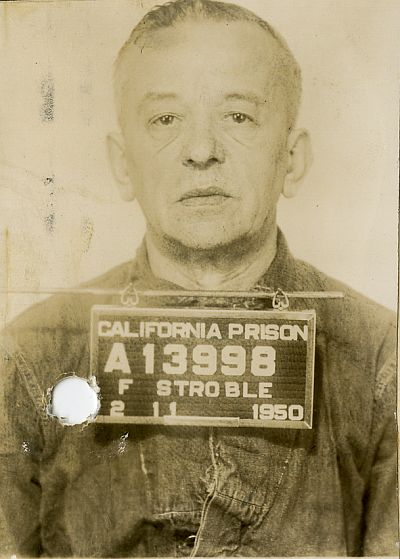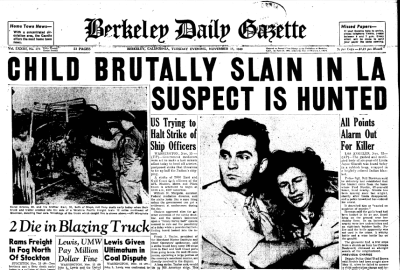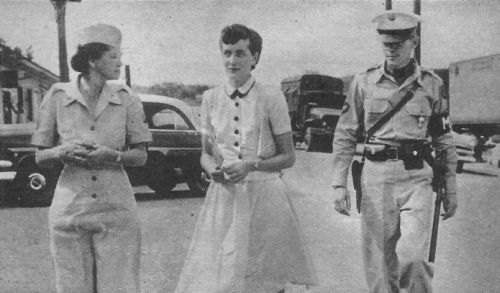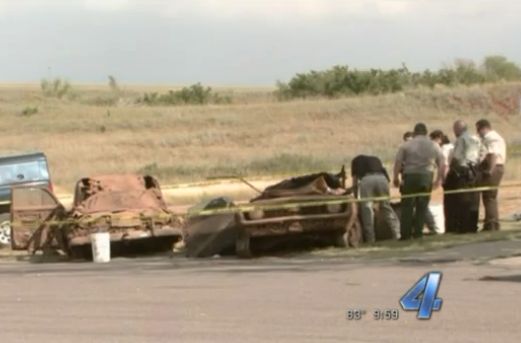Update to this story posted on May 16, 2018: Earlier this year, a graduate student in cinema directing at Columbia College in Chicago discovered this unique story of two women who married in small town Colorado in 1913. For her, this story connected with her own struggles in her native Russia. After reading about this unique case of an incredibly rare female-female union in American history, Ksenia Ivanova knew she had to center her required thesis film, a short narrative of ten to fifteen minutes, on the story of Colorado’s first same-sex marriage between “Handsome Jack” Hill, aka Helen Hilsher, and Anna Slifka.
In 2013 I accidentally discovered this story and by assembling articles that were available in online newspaper archives back then, I put together this short post of what I believe is the first retelling of this story in 100 years. Maybe.
 In 2017, a writer named Amy Hughes found greater resources not available to me in 2013 and wrote a truly excellent piece about Jack and Anna (which is no longer available online). The Hughes article goes into greater detail and lays the foundation for why this remarkable story, buried for more than 100 years, should be awakened and cast toward the screen to be seen by all–not just those who concern themselves with LGBTQ issues.
In 2017, a writer named Amy Hughes found greater resources not available to me in 2013 and wrote a truly excellent piece about Jack and Anna (which is no longer available online). The Hughes article goes into greater detail and lays the foundation for why this remarkable story, buried for more than 100 years, should be awakened and cast toward the screen to be seen by all–not just those who concern themselves with LGBTQ issues.
“The story of Jack and Anna is unique because there are not many stories that show how members of the LGBTQ community have struggled,” Ksenia recently wrote on her project funding page. “Since this story happened in 1913, it makes their choice to fight for their happiness even more powerful, because at that time it wasn’t even possible.”
But great story telling on film doesn’t come cheap and the cost of Ksenia’s one-of-a-kind project is approximately $15,000. A pie chart on her funding page breaks it all down, but the director with a vision is determined to make it happen, and has already received some impressive grant money from some impressive organizations.
“We are winners of several grants such as the Albert P. Weisman Award, Carole Fielding Student Grant, and The Arch and Bruce Brown Foundation Grant,” the young filmmaker wrote. “We have raised $5,000 so far but this is not enough to bring ‘Jack and Anna‘ to life.”
They have $10,000 to go and Ksenia and her troop of eight talented associates are asking for you to make a donation. It’s not really a donation, though, because they will give you back what they can–cool stuff that only comes with being involved in the industry.
Ever wanted to be a producer for a film? Donate $1,000 or $500 and you got it, executive level or associate. Working downward from $100 to $5 will get you autographed scripts, copies of the film, film credits, film posters, and social media shout outs.
Myself, I’m donating. I think it’s an awesome project with great potential to grow naturally into a major motion picture.
Check out the IndieGoGo fundraising page for this unique project where you can learn more, and have options to donate at different levels from $5 to $1,000.
—–Story Begins Below—–
Handsome Jack Hill Turns Out To Be A Woman
MEEKER, Colo., Sept. 20, 1913.— ‘Handsome Jack” Hill, who for two years has been the ideal of masculinity in the eyes of the young women of Meeker and who was known to the men as “the chap who married the prettiest girl in the White River country,” is a woman.
The disclosure was made today and she was arrested and bound over to the October term the district court charged with impersonating a man.
Miss Anna Slifka, whom the good looking “Jack” Hill married, today supplemented her “husband’s” confession with one in which she stated that she knew before the “marriage” that “her husband’s” name was Helen Halstead and that the two planned the affair so they might work together in earning money to take both of them through an eastern college.
Two years ago Helen Halstead arrived here attired as a man. “He” quickly ‘became the beau of the town, courting many but finally centering “his” attentions on Miss Slifka. Miss Slifka’s brother recently became suspicious and started an investigation which resulted in revealing the “bridegroom’s” identity.
“I dressed in boy’s clothing and came west because I wanted to work my way through college,” she said today.
“A working girl hasn’t any chance in the east and I thought I could dress like a man and get work on ranch in the west where I could earn enough by drawing a man’s wages to start me in a good school.”
United Press via The Des Moines News, Sept. 20, 1913, page 1.
Girl Wore Men’s Clothes to Aid Troubled Chum
Denver, Colo., Sept. 23, 1913.—Handsome Jack Hill or Helen Hilsher, her real name, was not the Beau Brimmel of Meeker, the cowboy hero with broad shoulders and movie manners who deceived a maiden fair.
She looks like a 16-year-old schoolboy and weighs only ninety pounds, according to her friend, Dr. Helen Jones, with whom the girl is staying in seclusion here.
“It is a mystery how Helen could have deceived the people of Meeker for so long, masquerading as a man,” said Dr. Jones today.
“The whole thing is a joke. Helen sacrificed her sex to help her chum, Anna Slifka, whom she “married” some months ago. Anna is an ambitious German girl who wanted to go to college and could not save enough money to do so because it is a German custom for children to give their parents their money. Gossipers put the idea into Helen’s head to ‘get married’ and end the talk, and at the same time allow Anna to keep her money.
“The girls agreed before the arrest that no matter what came they would both swear that Helen was a man. Anna got on the witness stand and declared Helen was a man and stuck to it. She had not seen her ‘husband’ and did not know that Helen had been forced to break down.”
United Press via The Des Moines News, Sept. 25, 1913, page 1.
A Meeker Malfeasance
Two years ago, “Jack” Hill, a feminine looking young man, came to Meeker from a Denver employment agency and took a position as dishwasher at the Davitt House (a restaurant and bar), also acting as a waiter. Finally, “Jack” became a bartender in the Davitt Bar.
While holding this position, he met Miss Anna Slifka, whom he married a year ago. A short time later, after they married, he quit the business, and he and his wife were employed on a ranch. A few days ago, W. B. Thompson arrived in Meeker from Denver, and having seen “Jack” in Denver, recognized “Jack” while he was in his brother-in-law’s shoe shop. When “Jack” left the place Thompson proceeded to tell Slifka that “Jack” was a girl in men’s clothing.
Slifka confronted “Jack” who told him that he had been misinformed, but this did not satisfy Slifka. He went before Judge Sanderson and swore out a warrant for “Jack” Hill’s arrest.
Judge Sanderson appointed Dr. French to investigate, and when the doctor approached Hill, Hill said he was a man and offered to pay the doctor well if he would establish it. [This is another way of saying “Jack” tried to bribe the doctor.] Dr. French was persistent and upon examination found Hill to be a woman.
Hill broke down and admitted she was a girl, and that her name was Helen Halstead, that she was a graduate of North Denver High School and that she had taught school in the vicinity of Denver.
She had made her home with a female doctor of Denver, and had decided to get a college education and thought that as a man she could command better wages. The girl was bound over to the district court.
The Denver News says that Miss Helen Halstead is not known in Denver. According to Miss E.E. Maxwell of the North Denver High School, no graduate of that name has received a sheepskin from the North Denver institution during the past few years. Prof. E.L. Brown of the High school remembers no girls of that name in the various classes.
[Halsted was an alias. Helen’s real last name was Hilsher.]
The Summit County Journal and Breckenridge Bulletin, Sept. 26, 1913, page 8.
Masqueraded As Man And Wed
“MEEKER, COLO, Sept. 27, 1913 – “I would not go through with it again for a million dollars. It is all a horrible nightmare to me now that it’s over and I am glad to be wearing dresses again like other girls.”
Helen Hilsher, the pretty girl of 23 who masqueraded as a man for two years in Meeker and even married Miss Anna Slifka, the town’s beauty, thus expressed herself when interviewed in the county jail, where she is awaiting trial in the district court on the charge of impersonating a man.
“Handsome Jack” Hill, as Miss Hilsher was known during the months of her masquerade, expressed repentance for her deception, but reiterated her previous statements that she had donned the habiliments of man in order to earn a man’s wages and gain enough money to assist her to a college education. She declared she believed she was justified in going to these lengths to gain so worthy an object.
Pressed for an explanation of why it was necessary to “marry” Miss Slifka, the masquerader smiled and related her experiences with the young girls of town.
“When I came here,” she said, “the girls dubbed me “Handsome Jack.” I liked the excitement and fun of the thing at first and enjoyed myself thoroughly. But the girls just wouldn’t leave me alone. They worried me to death with hints to take them to parties and other social events.
“I got tired of it all and I found I just had to tell someone and confided my secret to Miss Slifka. She was a trump and when we both found that our wish to go to an eastern college was mutual, we planned our “marriage.” You see, I knew if I got married, the girls would not bother me. So we fixed it that I was to wed and win Anna. I became an ardent wooer and courted many girls but finally settled my affection on Anna and we were married. Our courtship ended in our marriage 10 months ago.
“Everything was going lovely when I was arrested. We had moved to our homestead and were getting along happily. We were not doing anything wrong or bothering anybody and both of us were saving nicely. I cannot see yet what I have done to deserve arrest.”
It developed that the girl’s statement that she came from the east was fiction. She formerly lived in Denver. Six years ago, she proved upon public land and it was during this experience, she says that she found masculine attire comfortable and of assistance during employment.
During “Handsome Jack’s” two years in and around Meeker, she cooked in a hotel, worked for various bachelor businesses and ranches before taking up the homestead where “he” and his “bride” were living when Jack was arrested.
Oakland Tribune, Sept. 28, 1913, page 1.
Court Testimony
During a court hearing which took place at an unspecified date, Helen Hilsher’s testimony revealed more interesting facts about this case.
“Miss Hilsher,” asked the attorney for the defense, “did you mean any wrong when you went into this marriage?”
“Why certainly not. I wouldn’t harm Anna for the world.”
“Did Miss Slifka know your sex before you were married?”
“Of course she did.”
“And did she know it afterward?”
“Most certainly.”
“How else are you sure she knew of it?”
“Well, she answered at last, “Anna took part of my wardrobe, including a corset, shirtwaist, and skirt. I still love Anna.”
“Naturally, a man wouldn’t give a girl he was engaged to some other woman’s clothing.”
“I shouldn’t think so,” Helen answered.
“Now, Miss Hilsher, the question no doubt rather puzzles this honorable court to know just how you should desire to enter into a contract of this kind. Will you kindly explain it? Just tell it all, in your own way.”
“Well, when Anna and I met we liked each other from the start. We got to going together. Of course, I knew I was a woman and she knew I was a woman but other people didn’t. We got to going to each other’s rooms a good deal. Of course, with us it didn’t make any difference but other people didn’t know and they talked. We knew they were talking a lot and gossiping about us, so we just decided to end the whole thing by getting married. And that’s what we did. We couldn’t very well do anything else. You see, I’d worn men’s clothes around here all the time and I couldn’t come out and say I was a woman. That would cause more talk than ever. So we just got married.”
Related Story: Bert Martin, Horse thief 1900
—###—
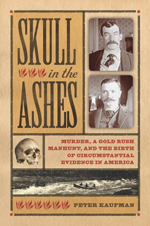 Skull in the Ashes: Murder, a Gold Rush Manhunt, and the Birth of Circumstantial Evidence in America, by Peter Kaufman
Skull in the Ashes: Murder, a Gold Rush Manhunt, and the Birth of Circumstantial Evidence in America, by Peter Kaufman


